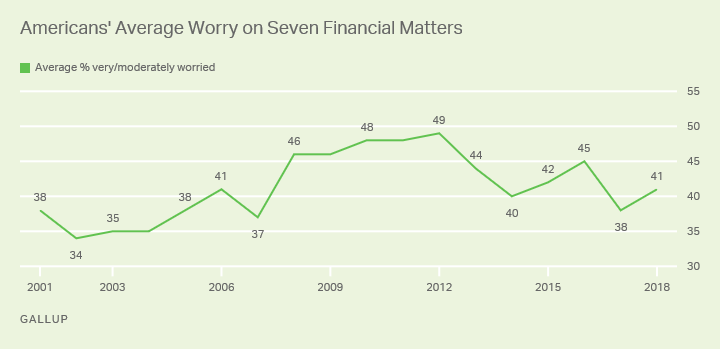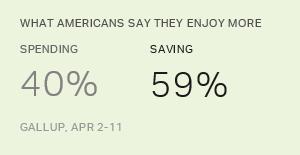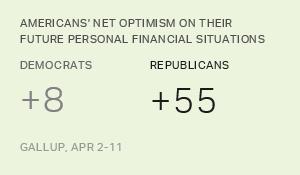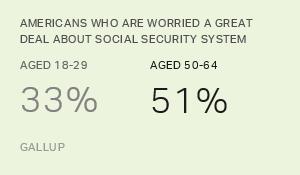Story Highlights
- Nearly six in 10 Americans worry about paying costs of a major illness/accident
- Same level worry about having enough money for retirement
- Retirees express far less concern than nonretirees about most costs
WASHINGTON, D.C. -- Lacking money to pay for medical care in the case of a serious illness or accident and running out of money in retirement tie as the most worrisome of eight financial issues Americans rated in a recent Gallup poll. Nearly six in 10 U.S. adults say they are very or moderately worried about each of these long-term financial challenges. About a third are worried about the more pressing concerns of paying their rent or mortgage and meeting their monthly bills.
| Very/Moderately worried | Not too/Not at all worried | ||||||||||||||||||||||||||||||||||||||||||||||||||||||||||||||||||||||||||||||||||||||||||||||||||
|---|---|---|---|---|---|---|---|---|---|---|---|---|---|---|---|---|---|---|---|---|---|---|---|---|---|---|---|---|---|---|---|---|---|---|---|---|---|---|---|---|---|---|---|---|---|---|---|---|---|---|---|---|---|---|---|---|---|---|---|---|---|---|---|---|---|---|---|---|---|---|---|---|---|---|---|---|---|---|---|---|---|---|---|---|---|---|---|---|---|---|---|---|---|---|---|---|---|---|---|
| % | % | ||||||||||||||||||||||||||||||||||||||||||||||||||||||||||||||||||||||||||||||||||||||||||||||||||
| Not being able to pay medical costs in the event of a serious illness or accident | 58 | 41 | |||||||||||||||||||||||||||||||||||||||||||||||||||||||||||||||||||||||||||||||||||||||||||||||||
| Not having enough money for retirement | 58 | 39 | |||||||||||||||||||||||||||||||||||||||||||||||||||||||||||||||||||||||||||||||||||||||||||||||||
| Not being able to pay medical costs for normal healthcare | 44 | 53 | |||||||||||||||||||||||||||||||||||||||||||||||||||||||||||||||||||||||||||||||||||||||||||||||||
| Not being able to maintain the standard of living you enjoy | 43 | 56 | |||||||||||||||||||||||||||||||||||||||||||||||||||||||||||||||||||||||||||||||||||||||||||||||||
| Not having enough money to pay for your children's college | 37 | 32 | |||||||||||||||||||||||||||||||||||||||||||||||||||||||||||||||||||||||||||||||||||||||||||||||||
| Not having enough to pay your normal monthly bills | 34 | 65 | |||||||||||||||||||||||||||||||||||||||||||||||||||||||||||||||||||||||||||||||||||||||||||||||||
| Not being able to pay your rent, mortgage or other housing costs | 30 | 66 | |||||||||||||||||||||||||||||||||||||||||||||||||||||||||||||||||||||||||||||||||||||||||||||||||
| Not being able to make the minimum payments on your credit cards | 18 | 64 | |||||||||||||||||||||||||||||||||||||||||||||||||||||||||||||||||||||||||||||||||||||||||||||||||
| Gallup, April 2-11, 2018 | |||||||||||||||||||||||||||||||||||||||||||||||||||||||||||||||||||||||||||||||||||||||||||||||||||
While not of great concern to majorities of Americans, affording medical costs associated with normal healthcare (44%) and failing to maintain the standard of living they enjoy (43%) are significant concerns to more than four in 10 adults.
Slightly fewer Americans, 37%, worry about not having enough money to put a child through college. However, this rises to 70% of adults with children under age 18.
Of the financial challenges measured in the April 2-11 Gallup poll, Americans are least likely to be concerned about not being able to make the minimum payments on their credit cards (18%).
The rank order of concerns since 2001 has been similar to the one seen this year, although more typically, retirement has edged out major medical expenses as the top concern.
More details on these data, including the percentages of Americans very worried about each financial possibility, are available in the PDF document linked at the end of the article.
Lack of Money for Retirement Concerns Six in 10 Nonretirees
The rank order of financial concerns is fairly similar for retired and nonretired Americans, but the degree to which each group worries about the issues reflects their different life stages. Nonretirees are much more likely than retirees to worry about paying for their children's college and funding their retirement -- there is more than a 20-percentage-point gap in the percentages very or moderately worried about each. Nonretirees are also a bit more likely to worry about paying for normal and critical medical care, as well as housing costs. Retirees' access to Medicare for their healthcare needs likely factors into their greater comfort about affording medical costs.
The two groups are the most similar in worrying about maintaining their standard of living, making minimum payments on credit cards and paying normal monthly bills.
| Not retired | Retired | Difference | |||||||||||||||||||||||||||||||||||||||||||||||||||||||||||||||||||||||||||||||||||||||||||||||||
|---|---|---|---|---|---|---|---|---|---|---|---|---|---|---|---|---|---|---|---|---|---|---|---|---|---|---|---|---|---|---|---|---|---|---|---|---|---|---|---|---|---|---|---|---|---|---|---|---|---|---|---|---|---|---|---|---|---|---|---|---|---|---|---|---|---|---|---|---|---|---|---|---|---|---|---|---|---|---|---|---|---|---|---|---|---|---|---|---|---|---|---|---|---|---|---|---|---|---|---|
| % | % | pct. pts. | |||||||||||||||||||||||||||||||||||||||||||||||||||||||||||||||||||||||||||||||||||||||||||||||||
| Paying for children's college | 45 | 10 | 35 | ||||||||||||||||||||||||||||||||||||||||||||||||||||||||||||||||||||||||||||||||||||||||||||||||
| Having enough money for retirement | 63 | 37 | 26 | ||||||||||||||||||||||||||||||||||||||||||||||||||||||||||||||||||||||||||||||||||||||||||||||||
| Paying medical costs in case of serious illness/accident | 60 | 49 | 11 | ||||||||||||||||||||||||||||||||||||||||||||||||||||||||||||||||||||||||||||||||||||||||||||||||
| Paying rent, mortgage or other housing costs | 32 | 21 | 11 | ||||||||||||||||||||||||||||||||||||||||||||||||||||||||||||||||||||||||||||||||||||||||||||||||
| Paying medical costs for normal healthcare | 46 | 36 | 10 | ||||||||||||||||||||||||||||||||||||||||||||||||||||||||||||||||||||||||||||||||||||||||||||||||
| Paying normal monthly bills | 35 | 28 | 7 | ||||||||||||||||||||||||||||||||||||||||||||||||||||||||||||||||||||||||||||||||||||||||||||||||
| Making minimum payments on credit cards | 20 | 13 | 7 | ||||||||||||||||||||||||||||||||||||||||||||||||||||||||||||||||||||||||||||||||||||||||||||||||
| Maintaining standard of living you enjoy | 44 | 38 | 6 | ||||||||||||||||||||||||||||||||||||||||||||||||||||||||||||||||||||||||||||||||||||||||||||||||
| Gallup, April 2-11, 2018 | |||||||||||||||||||||||||||||||||||||||||||||||||||||||||||||||||||||||||||||||||||||||||||||||||||
Retirees' greater financial peace of mind can also be seen in the smaller number of financial matters they worry about compared with nonretirees. Forty-two percent of retirees vs. 22% of nonretirees are not worried about any of the eight financial issues. Conversely, 21% of nonretirees vs. 15% of retirees are worried about seven or eight of them.
Beyond age, there are significant gaps in worry by household income, with worry inversely correlated with the amount people make -- the higher the income, the less they worry. There are also sizable differences between non-Hispanic whites and all nonwhites, with nonwhites far more likely to harbor significant financial worries.
Additionally, consistent with their slightly higher average income and relatively positive views about economic matters with Republican Donald Trump in the White House, Republicans, including independents who lean Republican, harbor fewer financial worries than Democrats and Democratic leaners.
| No worries (zero) | Low worry (1-2) | Moderate worry (3-5) | High worry (6-8) | |||||||||||||||||||||||||||||||||||||||||||||||||||||||||||||||||||||||||||||||||||||||||||||||||
|---|---|---|---|---|---|---|---|---|---|---|---|---|---|---|---|---|---|---|---|---|---|---|---|---|---|---|---|---|---|---|---|---|---|---|---|---|---|---|---|---|---|---|---|---|---|---|---|---|---|---|---|---|---|---|---|---|---|---|---|---|---|---|---|---|---|---|---|---|---|---|---|---|---|---|---|---|---|---|---|---|---|---|---|---|---|---|---|---|---|---|---|---|---|---|---|---|---|---|---|---|
| % | % | % | % | |||||||||||||||||||||||||||||||||||||||||||||||||||||||||||||||||||||||||||||||||||||||||||||||||
| U.S. adults | 26 | 23 | 32 | 20 | ||||||||||||||||||||||||||||||||||||||||||||||||||||||||||||||||||||||||||||||||||||||||||||||||
| Retirement status | ||||||||||||||||||||||||||||||||||||||||||||||||||||||||||||||||||||||||||||||||||||||||||||||||||||
| Retired | 42 | 18 | 25 | 15 | ||||||||||||||||||||||||||||||||||||||||||||||||||||||||||||||||||||||||||||||||||||||||||||||||
| Not retired | 22 | 24 | 33 | 21 | ||||||||||||||||||||||||||||||||||||||||||||||||||||||||||||||||||||||||||||||||||||||||||||||||
| Age | ||||||||||||||||||||||||||||||||||||||||||||||||||||||||||||||||||||||||||||||||||||||||||||||||||||
| 18 to 34 | 21 | 21 | 36 | 22 | ||||||||||||||||||||||||||||||||||||||||||||||||||||||||||||||||||||||||||||||||||||||||||||||||
| 35 to 54 | 18 | 25 | 34 | 23 | ||||||||||||||||||||||||||||||||||||||||||||||||||||||||||||||||||||||||||||||||||||||||||||||||
| 55 and older | 36 | 22 | 27 | 16 | ||||||||||||||||||||||||||||||||||||||||||||||||||||||||||||||||||||||||||||||||||||||||||||||||
| Race | ||||||||||||||||||||||||||||||||||||||||||||||||||||||||||||||||||||||||||||||||||||||||||||||||||||
| Non-Hispanic white | 32 | 26 | 29 | 13 | ||||||||||||||||||||||||||||||||||||||||||||||||||||||||||||||||||||||||||||||||||||||||||||||||
| Nonwhite | 12 | 17 | 37 | 34 | ||||||||||||||||||||||||||||||||||||||||||||||||||||||||||||||||||||||||||||||||||||||||||||||||
| Annual household income | ||||||||||||||||||||||||||||||||||||||||||||||||||||||||||||||||||||||||||||||||||||||||||||||||||||
| Less than $30,000 | 10 | 9 | 38 | 43 | ||||||||||||||||||||||||||||||||||||||||||||||||||||||||||||||||||||||||||||||||||||||||||||||||
| $30,000-<$75,000 | 23 | 21 | 34 | 23 | ||||||||||||||||||||||||||||||||||||||||||||||||||||||||||||||||||||||||||||||||||||||||||||||||
| $75,000 or more | 37 | 34 | 25 | 4 | ||||||||||||||||||||||||||||||||||||||||||||||||||||||||||||||||||||||||||||||||||||||||||||||||
| Party ID | ||||||||||||||||||||||||||||||||||||||||||||||||||||||||||||||||||||||||||||||||||||||||||||||||||||
| Republican/Lean Republican | 37 | 27 | 24 | 12 | ||||||||||||||||||||||||||||||||||||||||||||||||||||||||||||||||||||||||||||||||||||||||||||||||
| Democrat/Lean Democratic | 19 | 21 | 36 | 24 | ||||||||||||||||||||||||||||||||||||||||||||||||||||||||||||||||||||||||||||||||||||||||||||||||
| Gallup, April 2-11, 2018 | ||||||||||||||||||||||||||||||||||||||||||||||||||||||||||||||||||||||||||||||||||||||||||||||||||||
Financial Worry Stable at Post-Recession Level
Gallup has tracked Americans' levels of worry about seven of the eight financial matters annually since 2001, while the measure about paying for college was added in 2007.
The percentages worried about the seven long-term trends have varied in tandem over that time, increasing during the late 2007 to 2009 recession and remaining elevated until recently. This can be seen in the average very/moderately worried percentage across all seven items from 2001 through today.
The current 41% average worry level is consistent with the 38% to 45% range seen since 2013, while down from the 46% to 49% average percentage worried from 2008 through 2012. Financial worry was a bit lower before 2008, averaging below 40% most years.

Bottom Line
After easing in 2017, Americans' financial anxiety continues to be down from its higher 2008 through 2012 levels during the recession and extended post-recession years. Nevertheless, most Americans have at least one financial worry weighing on them, and about half harbor three or more worries. Concern about funding retirement and paying for serious medical problems is especially pervasive among nonretired adults. Whether the lower concern seen on these and other matters among retirees is something that occurs naturally once people experience retirement for themselves, or that will have to be won through the hard work of saving and planning, isn't clear.
Survey Methods
Results for this Gallup poll are based on telephone interviews conducted April 2-11, 2018, with a random sample of 1,015 adults, aged 18 and older, living in all 50 U.S. states and the District of Columbia. For results based on the total sample of national adults, the margin of sampling error is ±4 percentage points at the 95% confidence level. All reported margins of sampling error include computed design effects for weighting.
Each sample of national adults includes a minimum quota of 70% cellphone respondents and 30% landline respondents, with additional minimum quotas by time zone within region. Landline and cellular telephone numbers are selected using random-digit-dial methods.
View survey methodology, complete question responses and trends.
Learn more about how the Gallup Poll Social Series works.





